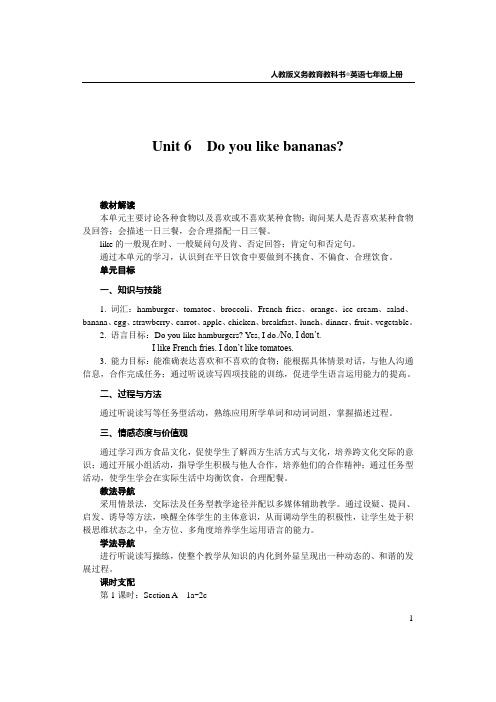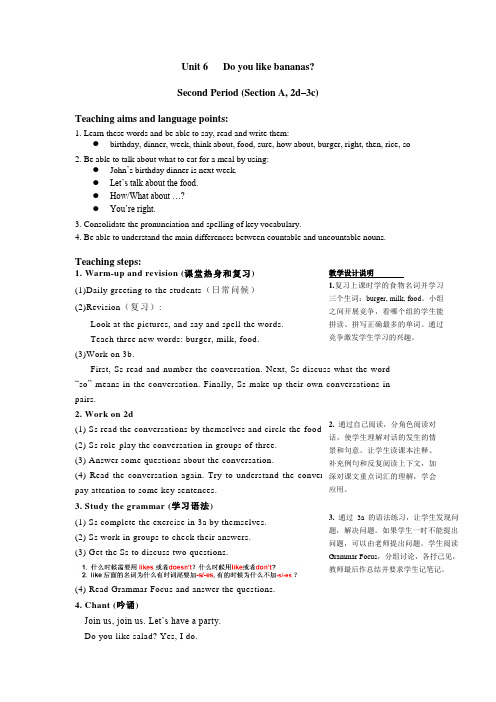人教版新目标七年级上册英语课本 第六单元
- 格式:doc
- 大小:629.39 KB
- 文档页数:6

人教版义务教育教科书◎英语七年级上册Unit 6 Do you like bananas?教材解读本单元主要讨论各种食物以及喜欢或不喜欢某种食物;询问某人是否喜欢某种食物及回答;会描述一日三餐,会合理搭配一日三餐。
like的一般现在时、一般疑问句及肯、否定回答;肯定句和否定句。
通过本单元的学习,认识到在平日饮食中要做到不挑食、不偏食、合理饮食。
单元目标一、知识与技能1. 词汇:hamburger、tomatoe、broccoli、French fries、orange、ice cream、salad、banana、egg、strawberry、carrot、apple、chicken、breakfast、lunch、dinner、fruit、vegetable。
2.语言目标:Do you like hamburgers? Yes, I do./No, I don’t.I like French fries. I don’t like tomatoes.3. 能力目标:能准确表达喜欢和不喜欢的食物;能根据具体情景对话,与他人沟通信息,合作完成任务;通过听说读写四项技能的训练,促进学生语言运用能力的提高。
二、过程与方法通过听说读写等任务型活动,熟练应用所学单词和动词词组,掌握描述过程。
三、情感态度与价值观通过学习西方食品文化,促使学生了解西方生活方式与文化,培养跨文化交际的意识;通过开展小组活动,指导学生积极与他人合作,培养他们的合作精神;通过任务型活动,使学生学会在实际生活中均衡饮食,合理配餐。
教法导航采用情景法,交际法及任务型教学途径并配以多媒体辅助教学。
通过设疑、提问、启发、诱导等方法,唤醒全体学生的主体意识,从而调动学生的积极性,让学生处于积极思维状态之中,全方位、多角度培养学生运用语言的能力。
学法导航进行听说读写操练,使整个教学从知识的内化到外显呈现出一种动态的、和谐的发展过程。
课时支配第1课时:Section A 1a-2c1第2课时:Section A 3a-3c第3课时:Section B 1a-2c第4课时:Section B 3a-Self Check课时教案第1课时Section A1a-2c教学目标一、知识与技能1. 掌握基本词汇:food、banana、hamburger、tomato、broccoli、French fries、strawberry、orange、ice cream、salad。

Unit 6 Do you like bananas?All roads lead to Rome.条条大路通罗马。
一、知识概述本单元需要学习和掌握以下几个方面的知识:1.掌握本单元出现的生单词、词组和句型。
2.学会使用like的肯定式、否定式和疑问式来谈论喜欢和不喜欢。
3.学习和掌握可数名词和不可数名词的含义和区别。
4.学会询问、了解别人的喜好以及表达自己的喜好。
二、语音知识三、单元重难点讲述1.—Do you like bananas?你喜欢香蕉吗?—Yes, I do. 是的,我喜欢。
—Do you like salad?你喜欢沙拉吗?—No, I don’t. 不,我不喜欢。
本句是含有实义动词like的一般疑问句。
like作及物动词,意为“喜欢”,后接名词、代词、不定式或动名词(动词+ing)作宾语。
(1)动词“like”的用法:① like+n.喜欢……e.g.I like English very much.我非常喜欢英语。
We like oranges.我们喜欢橘子。
② like+doing…喜欢做某事e.g.They like playing football.他们喜欢踢足球。
Do you like playing baseball?你们喜欢打棒球吗?③ like to do …喜欢做……,想做……e.g.Do you like to watch the football game?你想看足球赛吗?I like to go to school by bike today.我今天想骑车上学。
(2)要表达某人“喜欢……吗?”这个意思要用一般疑问句。
因为“like”是实义动词,所以要借助于助动词“do”或“does”来提问。
e.g.Do you like hamburgers?你喜欢汉堡吗?Does she like apples?她喜欢苹果吗?※对第一人称、第二人称和第三人称复数提问用“do”,对第三人称单数提问用“does”。

Unit 6 Do you like bananas?Second Period (Section A, 2d –3c)Teaching aims and language points:1. Learn these words and be able to say, read and write them:● birthday, dinner, week, think about, food, sure, how about, burger, right, then, rice, so 2. Be able to talk about what to eat for a meal by using:● John ’s birthday dinner is next week. ● Let’s talk about the food. ● How/What about …? ● You’re right.3. Consolidate the pronunciation and spelling of key vocabulary.4. Be able to understand the main differences between countable and uncountable nouns.Teaching steps:1. Warm-up and revision (课堂热身和复习) (1)Daily greeting to the students (日常问候) (2)Revision (复习):Look at the pictures, and say and spell the words. Teach three new words: burger, milk, food. (3)Work on 3b.First, Ss read and number the conversation. Next, Ss discuss what the word “so ” means in the conversation. Finally, Ss make up their own conversations in pairs.2. Work on 2d(1) Ss read the conversations by themselves and circle the food in it. (2) Ss role-play the conversation in groups of three. (3) Answer some questions about the conversation. (4) Read the conversation again. Try to understand the conversation better and pay attention to some key sentences. 3. Study the grammar (学习语法)(1) Ss complete the exercise in 3a by themselves. (2) Ss work in groups to check their answers. (3) Get the Ss to discuss two questions.(4) Read Grammar Focus and answer the questions. 4. Chant (吟诵)Join us, join us. Let’s have a party. Do you like salad? Yes, I do.2. 通过自己阅读,分角色阅读对话,使学生理解对话的发生的情景和句意。



Unit 6 Do you like bananas?一、单元教材分析本单元的核心项目是“喜欢和不喜欢(like and dislike)”。
围绕着这一中心项目,课文中设计了各种食物及水果的插图和不同形式的表格,让学生进行听、说、读、写等各种学习活动。
通过本单元的教学,使学生学会询问对方与了解别人喜欢与不喜欢的食物,学会谈论自己与他人早、中、晚餐喜爱吃的食物,为其今后能在交际中恰当地表达自己的情感、灵活运用已经学过的常用功能项目、进一步学习并掌握新的语言功能奠定坚实的基础。
本单元的重点内容仍然是行为动词在一般现在时句子中的使用,应该是上一个单元内容的延伸,通过本单元的教学,学生应初步掌握行为动词一般现在时的肯定句、否定句、特殊疑问句、一般疑问句的构成以及简单的回答。
二、单元学情分析本单元的主题是使用动词like询问对方对食物的喜好;谈论自己与他人喜欢吃的食物,学习并掌握行为动词的一般现在时的使用。
通过前一单元的学习,学生已经初步了解了行为动词一般现在时的构成及其使用,再通过本单元学生比较感兴趣的话题的操练,一定会使学生有更深刻的印象;同时教师要善于总结、比较以帮助学生了解构成规律,正确把握所学内容。
三、单元教学建议采用自主学习、小组合作探究、Different opinions和Classifying的学习策略,利用实物、教学图片等来展开课堂pairwork问答式或groupwork讨论式的口语交际活动,使用like询问对方对食物的喜好和谈论自己、他人喜欢吃的食物。
本单元的教学法建议:语音教学——让学生进行模仿操练;词汇教学——采取演示讲解的方式进行教学,让学生进行情景操练、反复使用;口语教学——采取pairwork问答式和groupwork讨论式的口语交际活动互相操练练习;阅读教学——让学生学会抓住主要词汇和句型;听力教学——采取图文配对和对话选择的方式;写作教学——以填空、造句为主;语法教学——比较不同、总结规律、模仿操练。
人教版新目标英语七年级上Unit 6单元教学设计一.教学内容及分析:本单元选自人教版新目标七年级上册Unit 6 Do you like bananas?这一单元主要围绕“谈论对事物的喜好”这一交际功能展开,并以like为例,进一步学习实意动词在一般现在时中的用法,是上一单元内容的延伸,主要语言功能项目是Talk about likes and dislikes. 语法结构为Present tense to like, Yes / No questions and short answers, Affirmative and negative statements. 本单元Section A主要让学生使用动词like询问他人是否喜欢某种食物。
学习一般现在时各个人称的肯定句,否定句和一般疑问句的构成以及回答。
本部分呈现了一些食物名词,让学生初步了解可数名词和不可数名词的概念,并让他们进一步归纳,总结名词复数的构成规律和使用方法。
“谈论饮食喜好”的话题贴近学生生活,容易激发学生的学习兴趣,使他们乐意参与相关的英语实践活动。
Section B是在Section A基础上的知识的扩展和延伸。
本单元中,Section B介绍更多的有关食物的词汇,听说活动,阅读活动和写作活动都围绕早餐,午餐和晚餐的话题展开,让学生进一步谈论人们对不同食物的喜好,反思不同的饮食习惯,并探讨健康饮食的问题,从而深化本单元的话题。
Self check部分的主要内容是对本单元主要词汇及语言运用能力的自我评价。
本单元语音学习内容包括:元音字母a及其字母组合ai,ay,al,aw的常见发音;名词复数词缀的发音;三音节词的重音。
名词复数词缀的发音与本单元语法学习内容相吻合,便于教师及时点拨。
单元的重难点内容仍是行为动词在一般现在时句子中的使用,特别是第三人称单数在一般现在时中的使用。
通过本单元的教学,学生应初步掌握行为动词在一般现在时句中的肯定句、否定句、一般疑问句的构成以及简单的回答。
Unit 6 Do you like bananas?1aMatch the words with thethings in the picture.将单词与图中物品配对。
1. hamburgers____d_____2. tomatoes __________3. oranges__________4. ice-cream __________5. salad__________6. bananas__________7. strawberries__________8. pears__________9. milk__________10. bread __________1b Listen and number the conversations[1-3]. 听录音,为对话编号。
A: Do you like salad? A: Do you like bananas? A: Do you like oranges?B: No, I don't. B: Yes, I do B: Yes, I do.1c Practice the conversations above with your partner. Then make your own conversations.练习上面的对话,然后与同伴编写新对话。
2a Listen and circle the food you hear. 听录音,圈出所听到的食物。
hamburgers pears tomatoes strawberriesoranges ice-cream salad bananas2b Listen again. Fill in the blanks.再听一遍录音并填空。
2c Practice the conversations above. Give answers that are true for you.练习上面的对话,并谈谈自己的真实情况。
2d Role-play the conversation. 分角色表演对话。
Jack: Hey, John's birthday dinner is next week. Let's think about the food. Tom: Sure. How about burgers, vegetable salad, andsome fruit?Bill: Sounds good. John likes hamburgers.Jack: Oh, I don't like salad.Bill: But John likes salad, and it's his birthday.Jack: Yes, you're right. What about the fruit?Tom: I think John likes strawberries and apples.Bill: OK. Let's have strawberries and apples then.Do you like salad?Yes, I do/No, I don't.Do they like pears?Yes, they do/No, they don't.Does she like tomatoes?Yes, she does/No, she doesn't.I like oranges.I don't like bananas.We like rice. We don't like hamburgers.He likes ice-cream. He doesn't like vegetables.Countable nouns Uncountable nouns Countable and uncountable nounsmilk, bread, rice food, fruit, ice-cream, salad, chicken hamburgers, eggs oranges,bananas, apples, pears,carrots, vegetables, tomatoes,strawberries3a Underline the correct words in the brackets. 在括号内正确的单词下面画线。
1. I like fruit, but I ( don't/doesn't) like vegetables.2. She (like/likes) bread, but she (doesn't/don't) like oranges.3. He (like/likes ) bananas, but he (don't/doesn't) like oranges.4.We (likes/like) hamburgers, but we don't (like/likes) chicken.5.They (likes/like) pears, but they(don't/doesn't) like strawberries.3b Number these sentences [1-4] to make a conversation.口So, let's get salad. 口Yes, I do. 口Do you like salad? 口OK.3c Ask your classmates aboutthe food in the chart. Find outwhat they like and don't like.调查你的同学,看看表中的食物他们喜欢什么,不喜欢什么。
1a Write the number of each word next to the correct food.将单词编号写在对应的食物旁边。
1.orange 3.eggs 5.ice cream 7.banana 9.rice2.salad 4.apple 6.hamburger 8.chicken 10.carrots1b How many other words can you add to the lists?fruit: pears,vegetables: carrots,1c1d Listen again. Fill in the chart.再听一遍录音并填表。
likes Doesn't likeTom carrots,Sally1e Ask and answer questions about what Sally and Tom like and don't like.根据萨莉和汤姆喜欢与不喜欢的食物与同伴进行问答。
2a Which food do you think is healthy? Check()Yes, Maybe or No.你认为哪种食物健康?在Yes, Maybe或No下打勾。
Food Yes Maybe Nofruitvegetableseggschickenhamburgers2b Read the magazine article and circle the food words.阅读杂志文章,圈出食物名称。
2c Write five sentences about Cindy's eating habits.写五个居住,读读辛迪的饮食习惯。
Cindy likes healthy food.1. Cindy________________________________________________2. She _________________________________________________3. She_________________________________________________4. Cindy doesn't_________________________________________5. She doesn't____________________________________________3a Complete the survey for you and your partner. 完成调查表,填写你和同伴喜欢的食物。
Do you like eggs for breakfast?No, I don't. I like oranges.Breakfast Lunch DinnerlikeI don't likeMy partner likesMy partner doesn't like3b Write about what you and your partner like and don't like for breakfast, lunch and dinner.写出你和同伴一日三餐喜欢吃什么,不喜欢吃什么。
For breakfast, I like_________________, but I don't like________________For lunch, ___________________________________________________ _And for dinner, _________________________________________________For breakfast, ________likes______________________________________ _For lunch,_____________________________________________________And for dinner,__________________________________________________ _1 What food/sports/colors do you like and dislike?你喜欢什么食物、运动、颜色?不喜欢什么?☺I like... ☹I don't like...2 Do you know the plurals of these words? Put them in the correct columns.下面单词的复数形式是什么?将它们写在相应的栏目里。